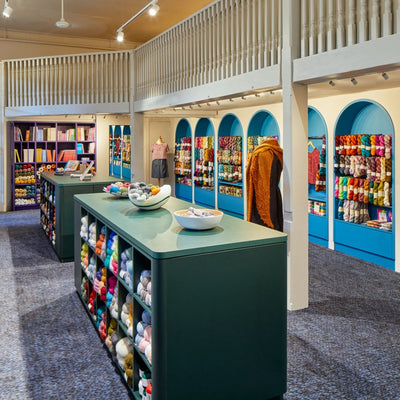5 Tips for Knitting With Dark Yarns
October 14 2025 – Angeles Rodrigué

There’s no denying the timeless appeal of dark knits — a black jumper that goes with everything, a deep blue cardigan that looks effortlessly polished, or that rich chocolate-brown wrap that feels extra cosy. They’re wardrobe staples for a reason!
But knitting them? Well, that’s a slightly different story. Those same beautiful shades that make finished garments so elegant can be a challenge when you’re mid-project — stitches vanish into the shadows, counting gets tricky, and your eyes might protest after a while.
Thankfully, with a few smart ideas (and some brilliant tips from our community), knitting with dark yarns doesn’t have to be daunting.
1. Light is Everything!
When it comes to knitting dark yarn, good lighting isn’t just helpful — it’s essential. Those beautiful deep tones can look stunning once finished, but they’re famously tricky to see as you work. Make things easier for yourself by knitting somewhere bright, ideally near a window where you can make the most of natural daylight.
If you’re an evening knitter, try setting up a focused task lamp or investing in a neck light so the stitches are well lit without harsh glare. Daylight bulbs are another great option for a soft, even light that’s kind on the eyes. The goal is simple: you should be able to see your stitches clearly and comfortably, without leaning forward or squinting. Once your lighting setup is right, you’ll find knitting dark yarn feels much less daunting — and a lot more enjoyable.
2. Choose the Right Needles
When you’re knitting dark yarn, the tools you use can make a huge difference. Dark stitches tend to blend together, so picking the right needles helps you see exactly where you are in your work. Lighter-coloured or reflective needles create a lovely contrast against deep shades — think pale wood, bamboo, or metal with a shiny finish. The clearer you can see each stitch, the fewer mistakes you’ll make (and the less unpicking you’ll have to do later!).
It’s also worth thinking about texture and comfort. Smooth needles help dark yarn glide more easily, especially if you’re working with fibres that have a bit of a halo. On the other hand, if your yarn is very slippery, a slightly grippier material like bamboo can help you stay in control.
Ultimately, it’s all about visibility and ease. A small switch — from dark to light needles — can make knitting dark yarns far less frustrating and much more enjoyable.
3. Rest Your Eyes
Working on a project with dark yarns can be surprisingly tiring for your eyes. When you’re knitting dark yarn, you’re constantly focusing on subtle contrasts and tiny details that can easily blur together. That’s why it’s so important to take regular breaks. Every 20–30 minutes, look up from your work and focus on something far away — it gives your eyes a chance to reset and relax.
You could even use these little pauses to stretch your hands and shoulders, sip your tea, or check your stitch count before you dive back in. A few mindful moments make a big difference, especially during long knitting sessions.
Community TIP: try placing a light-coloured fabric, like a pillowcase or tea towel, on your lap while you knit. It creates a bright background that makes dark stitches stand out beautifully — a simple trick that can really ease eye strain.
4. Start with Simple patterns
If this is your first time knitting with dark yarn, it’s a good idea to keep things simple. Choose patterns that don’t require too much counting or close-up checking, or patterns you are familiar with. Think smooth, easy textures like stocking stitch, garter stitch, or a gentle rib — all of which look lovely in darker tones and let the colour really shine.
Once you’re more comfortable, you can always move on to more intricate designs. But for that first project, give yourself the best chance to enjoy the process. Familiar or straightforward patterns let you find your rhythm without constantly squinting or second-guessing where you are.
After all, knitting dark yarn should still feel relaxing and satisfying — and with the right pattern choice, it absolutely can be.
Of course, that doesn’t mean dark yarns can’t be used for more elaborate projects. Just look at Joy’s stunning Bride Shawl, knit in Onyx — a brand-new shade of Townhouse Yarns Fade St 4ply. The lacework and texture in that piece prove that once you’re comfortable working with darker tones, you can absolutely tackle something more intricate and dramatic.
So start simple, find your confidence, and who knows — your next project in dark yarn might just be a showstopper like that one.
5.Count Your Stitches
When you’re knitting dark yarn, mistakes can be sneaky — a dropped stitch or missed yarn over can disappear into the shadows before you even spot it. That’s why counting your stitches regularly is such a simple but powerful habit. It helps you stay on track and saves you from the frustration of realising something’s gone wrong several rows later.
If you’re tackling a bigger or more intricate project, adding a lifeline is a smart move. It’s essentially a safety thread that runs through your stitches, so if you ever need to rip back, you’ll only lose a small section instead of your whole project. Stitch markers are another handy helper, especially when you’re working pattern repeats or shaping.
We’ve got tutorials on both counting stitches and using lifelines, check them out below.
Between good lighting, light-coloured needles, and a few clever habits, knitting dark yarn doesn’t have to feel like a challenge. A magnifying lamp can be a handy addition too, or you might prefer to save your darker projects for summertime when natural light lasts longer. However you approach it, remember that every knitter develops their own rhythm — so take your time and enjoy the process.
Simple Tools That Make Knitting Dark Yarns Easier
If you’d like to make knitting dark yarn a little easier, we’ve gathered a few tools that can really help — simple things that make a big difference, like good lighting options, light-toned needles, and clever accessories to keep your stitches on track. Think of it as a little toolkit to make those deep shades more enjoyable to work with, whether you’re knitting at home on a cosy evening or catching some daylight at your favourite spot by the window.







